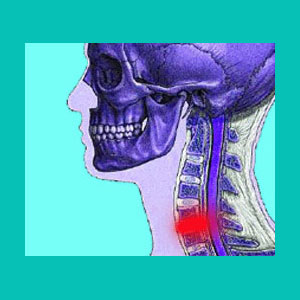
A herniated disc C5-C6 is the most common location for a cervical herniation to occur, just edging out C6/C7. This area, located in the lower middle of the neck, suffers constant use and abuse, since it is an intervertebral level which must bend and flex constantly throughout life.
The head is a very heavy weight which takes its toll on the small and thin cervical discs, causing mild to moderate cervical degenerative disc disease in most people by the age of 30. Being that disc degeneration helps facilitate herniation, it is no surprise that prolapse at C5/C6 is widely demonstrated in the general population.
This article will focus on disc protrusions at C5/C6 and will investigate why they occur, the symptoms they might produce and how many disc irregularities are mistakenly implicated in sourcing chronic neck and arm pain.
Herniated Disc C5-C6 Explained
C5/C6 resides in the lower middle region of the cervical spine and is a location which is prone to disc degeneration and bulging discs. Disc abnormalities at C5/C6 are frequently diagnosed as the sources of upper back, neck, shoulder and arm pain, when in fact, they may be completely innocent of causing these syndromes.
In some instances, a severe herniation can enact pain and neurological symptoms in any of these locations, but these events are rare, compared to the high incidence of asymptomatic disc bulging at the same level. Many cases of herniated discs at C5/C6 are completely asymptomatic and coincidental to any symptoms experienced.
When nerve compression or spinal cord compression can be definitively proven at C5/C6, then the diagnostic verdict is likely to be accurate and indicated treatments should be able to resolve the symptoms.
Bulging Disc C5-C6 Diagnostic Details
Herniated discs at C5/C6 can enact pain through foraminal stenosis, or more commonly, through spinal stenosis. The spinal cord begins to bend outwards near this level and posterior herniations can easily efface the thecal sac and sometimes can impinge on the spinal cord itself. Thecal sac compression is almost universally a nonissue, while cord displacement should be monitored. Spinal cord compression is almost always symptomatic and may produce nightmarish effects.
Finding a herniated intervertebral structure at C5/C6 should not be a surprise, since it is one of the most common locations in the anatomy for disc concerns. Remember that the vast majority of diagnosed patients do not have any pain or related neurological issues whatsoever. This condition is often found through diagnostic testing, which is unrelated to neck pain, such as in my case, which discovered 6 cervical herniated discs, including 2 really bad ones, in 2008.
Do You Have a Herniated Disc C5-C6?
If you have been diagnosed with a herniated disc or degenerative disc disease at C5/C6, you should not be shocked. In most cases, this condition has probably been there for a long time and is not the source of any chronic pain. In some cases, the herniation may produce minor symptoms and in very rare instances, the suffering may be severe and require drastic treatment or even surgical intervention.
If appropriate treatment for a C5/C6 disc bulge has not worked for you, there is an excellent chance that your condition has been misdiagnosed. In this case, I urge you to consider alternate explanations for your symptoms, including one of the most common: regional ischemia.
Herniated Disc > Herniated Disc Injury > Herniated Disc C5-C6




